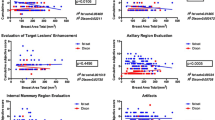Abstract
Purpose
To compare two fat suppression methods in contrast-enhanced MR imaging of breast cancer at 3.0 T: the two-point Dixon method and the frequency selective inversion method.
Materials and methods
Forty female patients with breast cancer underwent contrast-enhanced three-dimensional T1-weighted MR imaging at 3.0 T. Both the two-point Dixon method and the frequency selective inversion method were applied. Quantitative analyses of the residual fat signal-to-noise ratio and the contrast noise ratio (CNR) of lesion-to-breast parenchyma, lesion-to-fat, and parenchyma-to-fat were performed. Qualitative analyses of the uniformity of fat suppression, image contrast, and the visibility of breast lesions and axillary metastatic adenopathy were performed.
Results
The signal-to-noise ratio was significantly lower in the two-point Dixon method (P < 0.001). All CNR values were significantly higher in the two-point Dixon method (P < 0.001 and P = 0.001, respectively). According to qualitative analysis, both the uniformity of fat suppression and image contrast with the two-point Dixon method were significantly higher (P < 0.001 and P = 0.002, respectively). Visibility of breast lesions and metastatic adenopathy was significantly better in the two-point Dixon method (P < 0.001 and P = 0.03, respectively).
Conclusion
The two-point Dixon method suppressed the fat signal more potently and improved contrast and visibility of the breast lesions and axillary adenopathy.






Similar content being viewed by others
References
Orel SG, Schnall MD. MR imaging of the breast for the detection, diagnosis, and staging of breast cancer. Radiology. 2001;220:13–30.
Saslow D, Boetes C, Burke W, Leach MO, Lehman CD, Morris E, et al. American cancer society breast cancer advisory group. American Cancer Society guidelines for breast screening with MRI as an adjunct to mammography. CA Cancer J Clin. 2007;57:75–89.
Kuhl C. The current status of breast MR imaging. Part I. Choice of technique, image interpretation, diagnostic accuracy, and transfer to clinical practice. Radiology. 2007;244:356–78.
Niitsu M, Tohno E, Itai Y. Fat suppression strategies in enhanced MR imaging of the breast: comparison of SPIR and water excitation sequences. J Magn Reson Imaging. 2003;18:310–4.
Manganaro L, Fierro F, Tomei A, Irimia D, Lodise P, Sergi ME, et al. Feasibility of 3.0 T pelvic MR imaging in the evaluation of endometriosis. Eur J Radiol. 2012;81:1381–7.
Lin W, An H, Chen Y, Nicholas P, Zhai G, Gerig G, et al. Practical consideration for 3T imaging. Magn Reson Imaging Clin N Am. 2003;11:615–39.
Elsamaloty H, Elzawawi MS, Mohammad S, Herial N. Increasing accuracy of detection of breast cancer with 3-T MRI. AJR Am J Roentgenol. 2009;192:1142–8.
Kuhl CK, Jost P, Morakkabati N, Zivanovic O, Schild HH, Gieseke J. Contrast-enhanced MR imaging of the breast at 3.0 and 1.5 T in the same patients: initial experience. Radiology. 2006;239:666–76.
Cornfeld DM, Israel G, McCarthy SM, Weinreb JC. Pelvic imaging using a T1W fat-suppressed three-dimensional dual echo Dixon technique at 3T. J Magn Reson Imaging. 2008;28:121–7.
Frahm J, Haase A, Hänicke W, Matthaei D, Bomsdorf H, Helzel T. Chemical shift selective MR imaging using a whole-body magnet. Radiology. 1985;156:441–4.
Haase A, Frahm J, Hänicke W, Matthaei D. 1H NMR chemical shift selective (CHESS) imaging. Phys Med Biol. 1985;30:341–4.
Foo TKF, Sawyer AM, Faulkner WH, Mills DG. Inversion in the steady state: contrast optimization and reduced imaging time with fast three-dimensional inversion-recovery-prepared GRE pulse sequences. Radiology. 1994;191:85–90.
Bydder GM, Young IR. MR imaging: clinical use of the inversion recovery sequence. J Comput Assist Tomogr. 1985;9:659–75.
Dixon WT. Simple proton spectroscopic imaging. Radiology. 1984;153:189–94.
Berglund J, Ahlström H, Johansson L, Kullberg J. Two-point dixon method with flexible echo times. Magn Reson Med. 2011;65:994–1004.
Le-Petross H, Kundra V, Szklaruk J, Wei W, Hortobagyi GN, Ma J. Fast three-dimensional dual echo dixon technique improves fat suppression in breast MRI. J Magn Reson Imaging. 2010;31:889–94.
Dogan BE, Ma J, Hwang K, Liu P, Tse Yang WT. T1-weighted 3D dynamic contrast-enhanced MRI of the breast using a dual-echo dixon technique at 3T. J Magn Reson Imaging. 2011;34:842–51.
Le-Petross HT, Cristofanilli M, Carkaci S, Krishnamurthy S, Jackson EF, Harrell RK, et al. MRI features of inflammatory breast cancer. AJR Am J Roentgenol. 2011;197:769–76.
Gutierrez RL, Strigel RM, Partridge SC, DeMartini WB, Eby PR, Stone KM, et al. Dynamic breast MRI: does lower temporal resolution negatively affect clinical kinetic analysis? AJR Am J Roentgenol. 2012;199:703–8.
Parsian S, Rahbar H, Allison KH, Demartini WB, Olson ML, Lehman CD, et al. Nonmalignant breast lesions: ADCs of benign and high-risk subtypes assessed as false-positive at dynamic enhanced MR imaging. Radiology. 2012;265:696–706.
Baltzer PAT, Dietzel M, Burmeister HP, Zoubi R, Gajda M, Camara O, et al. Application of MR mammography beyond local staging: is there a potential to accurately assess axillary lymph nodes? Evaluation of an extended protocol in an initial prospective study. AJR Am J Roentgenol. 2011;196:641–7.
Kvistad KA, Rydland J, Smethurst HB, Lundgren S, Fjosne HE, Haraldseth O. Axillary lymph node metastasis in breast cancer: preoperative detection with dynamic contrast-enhanced MRI. Eur Radiol. 2000;10:1464–71.
Murray AD, Staff RT, Redpath TW, Gilbert FJ, Ah-See AK, Brookes JA, et al. Dynamic contrast enhanced MRI of the axilla in women with breast cancer: comparison with pathology of excised nodes. Br J Radiol. 2002;75:220–8.
Ma J. Dixon techniques for water and fat imaging. J Magn Reson Imaging. 2008;28:543–58.
Axel L, Kolman L, Charaffedine R, Hwang SN, Stolpen AH. Origin of a signal intensity loss artifact in fat-saturation MR imaging. Radiology. 2000;217:911–5.
Kerslake RW, Carleton PJ, Fox JN, Imire MJ, Cook AM, Read JR, et al. Dynamic gradient-echo and fat-suppressed spin-echo contrast-enhanced MRI of the breast. Clin Radiol. 1995;50:440–54.
Rankin SC. MRI of the breast. Br J Radiol. 2000;73:806–18.
Conflict of interest
The authors declare that they have no conflict of interest.
Author information
Authors and Affiliations
Corresponding author
About this article
Cite this article
Mikami, W.K., Kazama, T., Sato, H. et al. Fat suppression strategies in MR imaging of breast cancer at 3.0 T: comparison of the two-point Dixon technique and the frequency selective inversion method. Jpn J Radiol 31, 615–622 (2013). https://doi.org/10.1007/s11604-013-0230-8
Received:
Accepted:
Published:
Issue Date:
DOI: https://doi.org/10.1007/s11604-013-0230-8




